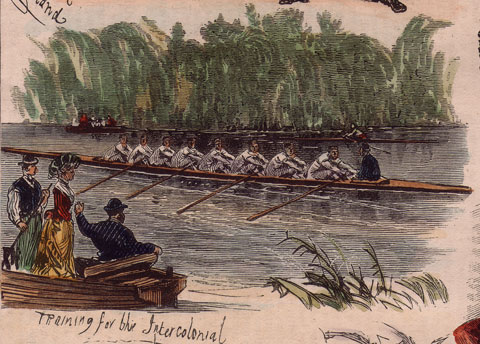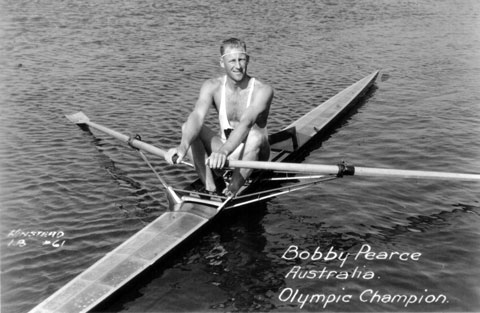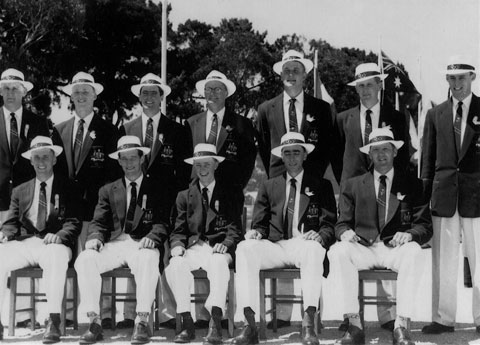History of Essendon Rowing Club, 1880-1980
Table of Contents
Chapters
- The Origins of the Sport
- The Development of the Sport
- The Founding of the Club - 1880-89
- Inter-club Competition - 1890-99
- Federation and Senior Success - 1900-09
- The War Years - 1910-19
- Recovery from the War - 1920-29
- Jubilee Year and Beyond - 1930-39
- Another War, Another Recovery - 1940-49
- Junior Sucess Again - 1950-59
- Senior Rise to the Top - 1960-69
- The New Clubhouse - 1970-79
Appendices
2. The Development of the Sport
The Victorian Rowing Association was formed in 1876, and is reported to be the oldest rowing association in the world. The N.S.W. Association was formed in 1878 and the Amateur Rowing Association (England) in 1882. The Victorian Rowing Association was formed at a meeting of oarsmen on October 7th, 1876, to conduct the Melbourne Regatta and to manage Victorian rowing affairs. The Association consisted of the following clubs: Albert, Albert Park, Ballarat, Ballarat City, , Banks, Barwon, Boroondara, Civil Service, Corio, Footscray, I Zingari, Melbourne, Murray, Richmond, University, Warehousemen, Williamstown and Yarra Yarra. The Committee consisted of ten 'elected' members and of one representative from each club subscribing £10 annually to the Association. The Committee was to exercise the rights, powers and privileges formerly possessed by the Melbourne Regatta Committee. The first event conducted by the V.R.A. was the holding of the scratch eights on November 25th, 1876. The first Melbourne Regatta arranged by the V.R.A. was on the Saltwater River on March 31st 1877. (Rickards 1976 page 8.)
Towards the end of 1877 the V.R.A. suggested to the Sydney rowing clubs that an intercolonial eight oared race be rowed on the Yarra. After some bickering the Mercantile Club of Sydney agreed to represent N.S.W., only to be defeated by the Victorian crew in 1878.

Victorian crew training for 1878 Intercolonial Championship
A hand pianted lithograph
N.S.W. and Victoria were the only representatives at intercolonial contests until 1885, then Tasmania and Queensland entered boats. Western Australia entered in 1897 and South Australia two years later. In 1902 all States took part at the same time - the race was held on the Port Adelaide River and was won by Victoria. Between 1878 and 1907 Victoria won 25 of 31 races held.
Regular annual sculling races for the Australian Amateur Title was not started until 1895, but there had been occasional championship races before that. The first took place on the Yarra on March 11th, 1868 when Arthur Nicholls of Victoria defeated H. Freeman of Sydney by 6 lengths. Another race was held on the Parramatta on May 10th 1884 when N.S.W. won. Up to 1954 when the title went to Western Australia, N.S.W. had held the title continuously since 1927, in which year H. R. (Rob) Pearce won it at Hobart. Pearce successfully defended his title for two more years and subsequently became the world amateur and professional sculling champion. Paired-oared and double sculling championships were held for the first time in 1953 at Perth.
In all States and a federal controlling body - the Australian Rowing Council, has been established. The principal national rowing events held annually are the Australian Eight Oared Championship for the King's Cup, the Australian Sculling Championship for the President's Cup, and the inter-varsity Eight Oared race for the Oxford and Cambridge Cup. These events are held in each State in turn.
Australians have featured particularly in the world professional sculling championships and have had a number of successes in Olympic and Empire Games and other international amateur competitions. The first Olympic rowing events in which Australia contested were the Games at Stockholm in 1912, when a largely Sydney Club Eight were narrowly defeated by an eight from the Leander Club (Great-Britain). The Murray Bridge eight competed at the Paris Games in 1924, but were defeated in the second round and A.G. Bull of N.S.W. was fourth in the single sculls. Bobby Pearce (N.S.W.) won the single sculls both at Amsterdam in 1928 and at Los Angeles in 1932.

The N.S.W. Police eight represented Australia at the Berlin Games in 1936. At the London Games in 1948 Mervyn Wood of N.S.W. won the single sculls from a field of 14 and was second to a Russian sculler at Helsinki in 1952. A coxed four and a coxless pair also took part in London but failed to reach the finals. At the Melbourne Olympics in 1956, three medals were won by the Australian team. A Bronze was awarded to the Eight Oared crew, Mackenzie from N.S.W. gained second place in the single sculls and Murray Riley and Merv Wood were third in the double sculls.

1956 Olympic Eight
Back row: Brian Dawes, David Boykett, James Howden, Robert Aitken, Fred Benfield, Michael Aikman, John Morganti
Front row: Neville Howell, Brian Doyle, Neil Hewitt, Adrian Monger, Garth Manton
Australia's first successes in the British Empire Games were in 1938 when they were held in Australia. The Australian team won the coxed four, the double sculls and the single sculls. The Eight came second to Great Britain. At the 1950 Empire Games held in New Zealand, Australia won every race on the program, except the coxed four which went to New Zealand.
